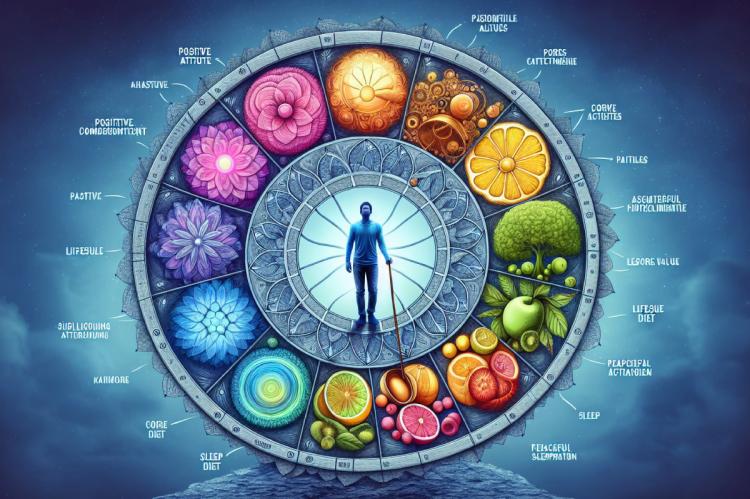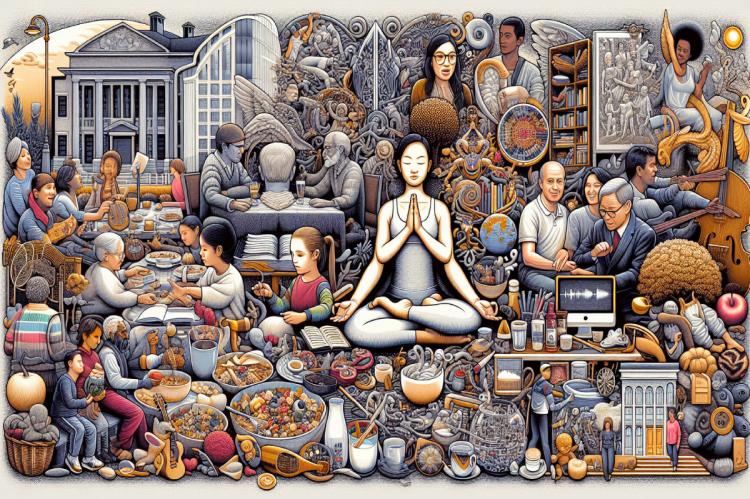Lifestyle Define or How to Define Your Lifestyle
Our lifestyle defines how we live, our habits, attitudes, and daily routines. Understanding lifestyle helps us see its impact on identity and well-being.
Let us explore lifestyle’s definition, history, key components, and its role in health and society.
Understanding the role of life style in modern society
- Lifestyle is a complex and multifaceted concept encompassing attitudes, habits, and possessions that reflect one’s identity, values, and social positioning.
- The term ‘lifestyle’ has evolved significantly since its early 20th-century origins, influenced by key scholars like Alfred Adler, Georg Simmel, Pierre Bourdieu, Max Weber, and Thorstein Veblen.
- Lifestyle choices impact health significantly, with the World Health Organization attributing 60% of individual health and quality of life factors to lifestyle, highlighting the importance of balanced diet, regular exercise, and mental well-being.
Defining Lifestyle
We start by dissecting this fascinating term. At its core, the definition of lifestyle is a tapestry woven from attitudes, habits, and possessions that characterize a person or a group. It’s an expression of identity, stretching across the internal landscape of our values and outwards to the material world. A lifestyle isn’t static; it’s a dynamic interplay of the internal, external, and temporal dimensions that shape our everyday experiences.
Delving further, we perceive lifestyle as a stable dimension., manifested in our daily actions and choices. It’s how a person lives, reflected in everything from the books on their shelf to their stance on social issues. This definition embraces both the tangible, such as demographic variables, and the intangible, like psychological aspects. It is these factors combined that give rise to different lifestyles—a concept as richly varied as humanity itself.
Moving seamlessly from theory to application, we can examine how a lifestyle might materialize in everyday life. A healthy lifestyle, for instance, is often visualized through the lens of exercise and nutrition. However, it could equally be about a mindset, where balance and wellness are prioritized in every decision. Such attitudes can play a significant role in maintaining a healthy lifestyle.
Conversely, a fashionable or desirable lifestyle, as promoted in lifestyle magazines, could emphasize the allure of the tangible—from a lifestyle property to the latest trend in lifestyle café, and even the use of lifestyle drugs.
Historical Context of Lifestyle
The roots of ‘lifestyle’ stretch back to the early 20th century when Alfred Adler first introduced the term, linking it to a person’s basic character established in childhood. Adler paved the way for a psychological understanding of lifestyle, setting the stage for future scholars to expand on his insights. Over time, the term evolved, broadening from an artistic style derivative in the 1950s to encompass the notion of a ‘way or style of living’ by the 1960s.
The historical tapestry of lifestyle studies is rich and varied. Some key scholars and their contributions include:
- Georg Simmel, who examined the role of lifestyles in individualization and social differentiation
- Pierre Bourdieu, who connected lifestyles to social practices and tastes, offering a more structural view
- Max Weber and Thorstein Veblen, who explored the connection between lifestyles and social strata, with Weber focusing on status groups and Veblen on emulation and conspicuous consumption
- Richard Jenkins and A. J. Veal, who honed in on the distinctive actions that define a lifestyle.
As we’ve journeyed through the decades, three main phases of life style studies have emerged: lifestyles as social positioning, as styles of thought, and as styles of action. The latter phase, in particular, focuses on the relationship between active choices and routine, providing a lens through which to view modern consumption patterns and daily life.
Lifestyle in American English
In the land where dreams are made and sold, the American interpretation of lifestyle carries a distinct sheen of success and prestige. Words like ‘affluence’ and ‘glamour’ are often nestled within the folds of its definition, illustrating a picture of life that many aspire to. This vision is propelled by lifestyle magazines and television shows that dangle before us the tantalizing possibility of living like the rich and famous, showcasing the allure of lavish lifestyles.
Yet, lifestyle in America isn’t just about emulating celebrities; it’s also about finding resonance with personal aspirations and values. Lifestyle brands and stores cater to this desire by targeting consumers who seek specific, often upscale, ways of living. They’re not just selling products; they’re selling a way of life, one that aligns with customer interests and aspirations.
Key Components of a Lifestyle
Focusing on the individual, we can investigate the key components that constitute a lifestyle. It’s a multifaceted concept, hinging on attitudes, values, and worldviews. These internal drivers are then mirrored externally through social positioning and collective behavioral patterns. Leisure activities are a vital sub-factor; their absence or neglect can have detrimental effects on our health and well-being.

Diet and sleep are two pillars of a healthy lifestyle that cannot be ignored. A balanced diet is critical in preventing obesity and related health problems, while sleep disorders can have sweeping consequences on our psychological and economic health. These components underscore the importance of considering both the intangible and tangible aspects of living.
Different Lifestyles
When we probe into the diversity of lifestyles, it becomes clear that luxury doesn’t always equate to extravagance. It’s about personalizing and mindfully integrating those elements that define luxury for an individual, whether it be advanced home technology or simple pleasures like fresh flowers. Self-care, too, is a pillar of luxurious living, emphasizing the importance of balancing fitness, relaxation, and financial security for a future of ease.

Considering the various lifestyles we come across, it’s evident that they are deeply intertwined with the psychology and personal choices of a particular person. From the design of one’s living space to the pursuit of at-home spa treatments, these choices are a distinctive pattern of living that mark significant changes in daily routines.
Lifestyle Choices and Social Values
Our choices are a loudspeaker for our values, broadcasting our beliefs and influencing our social interactions. Personal values, in particular, are the compass by which we navigate life’s myriad decisions, shaping our careers and personal development paths. In the modern world, these choices become a canvas, blurring the lines between self-identity and the social signals of a particular lifestyle.
The cornerstone of modern lifestyle construction, according to some, lies in consumption behavior. It’s a reflection of social practices and the social context, where even the way we spend money can reveal the fabric of our values and social position. And it’s not just about individual preferences; our social connections are often strengthened when we find common ground in shared values.
Lifestyle and Social Structure
Lifestyle choices are not made in a vacuum; they are often a response to the social structure we inhabit. The prestige associated with one’s social class can be expressed through various forms, such as living conditions or personal style. Veblen’s theory of ‘conspicuous consumption’ and Weber’s status groups underscore how lifestyles can be both a product of and a reaction to the economic status and social class.
Bourdieu’s take on lifestyles further connects them with social practices and tastes, painting them as an intricate interplay between individual habitus and the wider societal field. This perspective allows us to see lifestyles as a dynamic interplay between the agency of personal choice and the constraints of social structure.
Impact of Lifestyle on Health
Our lifestyle choices cast long shadows over our health and happiness. The World Health Organization asserts that 60% of individual health and quality of life factors are related to lifestyle, highlighting the magnitude of its impact. Regular physical activity and a diet rich in nutritious foods are not just hallmarks of a healthy lifestyle; they’re essential components that fuel our bodies and minds.

An unhealthy lifestyle, by contrast, is often signposted by malnutrition, substance abuse, and a sedentary routine. These factors can lead to a cascade of health issues, ranging from chronic illnesses to mental health concerns. Simple modifications, such as standing more, choosing healthier fats, and reducing sugar intake, can have profound effects on our overall well-being.
Examples of Lifestyle in Practice
Applying theory to practice, we can observe how lifestyles manifest in our daily lives. Self-love is a powerful practice that can enhance our confidence and life quality. Involving ourselves in enjoyable activities and reducing stress through meditation or sports can lead to a more joyful existence. Furthermore, embracing socialization and learning to set boundaries by saying no can contribute to a healthy and satisfying lifestyle.
Investing in self-development, whether through time or financial resources, can pay dividends in the quality of our lives. Trying new activities can inject energy into our routines, propelling us toward a more dynamic and fulfilling lifestyle.
Lifestyle in Media Culture
The media is a pervasive force, sculpting lifestyle trends and societal norms. It fosters a herd mentality, providing cues on how to blend in with the prevailing cultural winds. Lifestyle marketing takes this one step further, positioning products in alignment with the target market’s lifestyle, effectively tapping into their interests, attitudes, and values.

This strategy of psychographic segmentation classifies consumers based on lifestyles, allowing for a nuanced understanding of consumer behavior and preferences. It’s a powerful tool that shapes not only what we buy but how we perceive the very essence of living.
Fashionable or desirable lifestyle
As we wrap up our journey through the multifaceted concept of lifestyle, it’s clear that it is a complex, interwoven tapestry of internal and external factors that define our daily existence. From its roots in the early psychological theories of Adler to the modern-day implications of media culture, lifestyle remains a central element of individual identity and social structure.
Lifestyle is the combination of attitudes, habits, possessions, and values that characterize the way a person or group lives, reflecting their personality, social positioning, and changes over time.
The concept of lifestyle has evolved historically from psychological analysis to encompass broader social practices and individual tastes, studied through social positioning, thought styles, and action styles.
The lifestyle has a significant impact on health. Adopting a healthy lifestyle, which includes regular physical activity and a balanced diet, can boost energy and reduce the risk of chronic illnesses. Conversely, unhealthy lifestyle choices can lead to a host of health problems.
Media culture shapes lifestyle trends by dictating societal norms and driving consumer behavior through lifestyle marketing, ultimately influencing how individuals perceive and adopt certain lifestyles.
Personal values play a crucial role in guiding decision-making, shaping personal development, and influencing career paths, ultimately impacting lifestyle choices. It helps individuals align their actions with their true self and enhances self-awareness.
